You are currently browsing the dc comics category
So once again your pal Mike has an early morning meeting awaiting him, so I’m going to most just respond to Daniel’s comment from way-back-when today, as it is a very good commentary on continual rebootery vs. consistency’s hobgoblins.
Daniel thus spake
“Not sure if I’m in the minority or not, but I loved Crisis and (more importantly) the post-Crisis rebooted universe. I generally really liked a lot of the early New 52 reboot (until it became clear about six to eight months in that there really wasn’t much of a central plan to the reboot and that they hadn’t really learned anything from the mistakes of the post-Crisis universe). I like new beginnings. I like when things start over from ground zero.”
I honestly don’t think you’re in the minority at all in loving Crisis and the shenanigans that followed. I know there’s been a lot of knocking of Crisis in these here parts over the last week or so, but I started off saying that I unabashedly love the series, even as I’m aware of the storytelling shortcomings and the very much “ya hadda be there” requirement for the proper impact. I do love the series, I treasure that fancy slipcase edition from when it was first collected. Unlike most “important” event series, it actually Was Important, restructuring not only a publisher’s entire storytelling strategy but still influencing the industry in various ways several decades later.
And the New 52 was exciting, and maybe even a little frightening in a way…”what the hell is DC thinking,” that sort of thing. As you note, the excitement gave way to…what’s the right word? Dismay? Chagrin? Confusion, maybe? The apparently rushed nature of this restructuring became evident, and as the cancellations and the relaunches-of-the-relaunches started to hit and the flopsweat starting pouring from DC’s publishing plans, what was an immense hit became an progressing series of special events and an increasing reliance on variant covers to shore up sales.
I always feel like I have to note “but there were still good comics coming out from them” and there were, but the desperation of the gimmicky marketing was obvious.
“I like hard reboots. I like Elseworlds. I like the Burton-verse and the Nolan-verse and the Snyder-verse. I like getting into stories from the very beginning. I like variations on retelling the beginnings of these characters and seeing those retellings play out differently each time.
“The lesson of Crisis and the post-Crisis reboot is that these characters have finite potential. To my mind, attempting to perpetuate an ongoing, unending mega-continuity is doomed to fail. You can only have Joker escape from Arkham so many times before it becomes banal and loses narrative credibility.”
Different interpretations of your favorite characters by a wide range of creators is part of the charm of superhero comics and their spinoff media. There’s an appeal to getting in on the ground floor of things and trying to follow along and keep up with this fictional milieu as it builds up around you (though disappoint threatens when the publisher seems less devoted to the concept than you are — see again the New 52). I often get kids who pull a #3 of something off the shelf and immediately ask for #1 and #2, which…yes, of course, that’s a natural impulse. But let me expound on that for a moment.
When I was a kid, back in Ye Olden Tymes when dragons roamed the land, I didn’t think anything about getting issue number, what, 170 of the Fantastic Four. I might not have even been aware there was an issue number. I just knew that this was a thing (er, so to speak) that had been going on for a while, and the comic was clearly in the middle of a story so I obviously missed stuff that had happened previously…but I read and enjoyed it anyway. I had no access to back issues. And even if I did, it wasn’t like I was going to go buy issues 1 through 169, that’s too many. At most I would have gone one or two back.
Nowadays, a number one of anything isn’t too far away from the current issue. Even as Batman enters the early 100s, that still feels attainable, even if one has to resort to the paperback collections. It’s a combination of the perceived availability combined with the fact that many modern comics aren’t standalone enjoyable experiences in a way that even the serialized issues of decades past were, that the need to be there “at the beginning” has increasing among comics readership.
Is that a good thing or a bad thing? Short term is probably good, as first issues tend to get higher orders by retailers, though as more and more number ones flash by I imagine those orders are becoming increasingly conservative. But I know as a kid I liked the idea that I was dipping into a title with a long history, that was around long before I was born and would (theoretically) be around after I was gone. When Marvel did their “Legacy” numbering, when they returned numbers of various titles to where they would be if no relaunches had happened (generally in the hundreds), my sales on those actually went up. Probably not a universal happening, given that Marvel relaunched everything with new #1s anyway, but there may have been some people out there who liked seeing them big ol’ numbers.
But to your following point, Daniel, the need for companies (well, mostly DC, Marvel, despite the constant relaunches, hasn’t really rebooted their universe as such) to tie everything together stems from the difference in which comic books are consumed. Back again in Ye Olden Tymes, to my youth and decades earlier, the turnover in comics readership appeared to be reasonably high. Little Billy read Superman until he became Teen Billy and discovered girls or cars or both, giving up his readership spot to Little Johnny, coming up right behind him. There’s a reason why there’s only about a five year gap between DC retiring the Jay Garrick Flash and reintroducing the slick, new, For The Space Age Barry Allen Flash: enough time had passed that a new audience may cotton to an old concept with a fresh coat of paint.
That’s not true of every reader, of course…there were plenty who kept reading for years and years. But the common wisdom was that the turnover existed, and the need to maintain a consistent history and continuity was minimal. They were just kinda throwing stuff out there to entertain the kids…so long as the stories and characters remained relatively consistent within themselves, that was good enough, and nobody worried that (to use a popular example) the Atlantis Aquaman was from appeared to be different from the one Lori Lemaris lived in.
But as the average readership started sticking around longer and longer, and that turnover slowly dropped away, there was more demand for consistency. Plus, as the readers who didn’t give up on comics became creators themselves, a la Roy Thomas, additional emphasis was placed on remembering the older comics and having them influence, or directly impact, the new. Marvel’s advent in the ’60s and their attempts at actual world-building and crosscontinuity among their titles, not to mention their direct courting of older teen and collegiate readers, helped this transition along as well.
This is what fuels the need for DC to kitbash a consistent history for their superhero shared universe…reader expectations have grown to want this consistency. With DC’s incessant focus on undoing, redoing, or relitigating Crisis on Infinite Earths, the fans are encouraged to not stop worrying about whether this story fits with that story. They are kept constantly aware that DC’s shared universe is by its very nature a shambles, and that there is a never-ending need to fix it. That’s what Death Metal was about. So was Zero Hour. And Doomsday Clock. Some of the most successful comics DC has ever published have been on the topic of why DC Comics needs to be fixed.
When you say
“…DC should focus not on trying to stitch everything together, but rather on giving creators the freedom to tell as many variations on the basic mythology of each character as possible.”
…I 100% agree, and in fact I think DC tends to do…okay with that. But every year or three another Big Event Comic comes along to apply more patches to the DC Universe and all it really manages to do is remind us that supposedly It’s All One Big Thing and they’re gonna make it so by hook or by crook. If DC would stop doing that, maybe readers would stop worrying so much if events in the new Harley Quinn mesh up perfectly well with what’s going on in Teen Titans Academy.
You’ve got more comment to cover, Daniel, but I’ve got bedtime so it’ll have to continue another day, hopefully one without a morning appointment waiting for me the next day. Thanks for the comment, David, and thanks for reading, everyone else. See you Friday.
…and you have no idea how much I kicked myself when I realized my birthday/New 52 post was #5197. Man, how perfect would that have been if I had that total convergence of 52s for that. Well, crud.
Anyway, I’ll likely continue the New 52/rebootery theme next week, but I did want to drop in one point I was sort of thinking about regarding Crisis on Infinite Earths. As can be inferred from some of your reactions, and my reaction, to DC’s continuity-sweeping series, it’s pretty clear the series loses much of its impact removed from context.
I wrote about how startling it was for Earth-3 to be wiped out in the opening pages of the series. It immediately raised the stakes and there was a sense of permanence. “Worlds will live, worlds will die, and nothing will ever be the same!” shouted the ads, and we had no reason to disbelieve them. We’d never seen anything quite like this, on this scale, knowing that big changes were coming. If you were a DC fan at all, you had to read it because this is where All The Shit Was Going Down. It was literally An Event that we, fans reading comics in the mid-1980s, were experiencing in real time.
Going back to look at it, years, decades, later, the immediacy of this story’s content is no longer a factor. The importance of the changes are no longer noteworthy, except maybe in a strictly historical/academic view. The shocking deaths are no longer so shocking…Barry Allen and Superman’s cousin both seem to be alive and well, nowadays. And like I said, the main conceit of the series, that the idea of a “multiverse” would be going away, has been undone with DC dragging the concept back into existence.
“Thou shalt not read Crisis for the prose,” as today it exists primarily as an artifact of publishing strategy, not as a standalone story with a coherent plot. (Though the George Perez art still is beautiful, of course.) None of that is Marv Wolfman’s fault…well, okay, maybe some of the weird plot holes are, but the series succeeded in what it was meant to do…grab the attention of fans and slap a new coat of paint on things. It doesn’t stand the test of time because it wasn’t meant to.
Again, not to say there isn’t good stuff in there…there are fun interactions here and there, exciting action sequences, tiny one-panel showcases for characters both major and forgotten. And as noted, it’s all wonderfully illustrated. But a big part of what made Crisis work was how vital it was to stuff going on in the now of the 1980s, diminished with the repetition of character “death” fakeouts and universal rejiggerings and generational transitions of super identities in succeeding event series. Plus, of course, with the subsequent undoing of everything that was “never the same.”
A commenter noted that these sort of events create reader excitement and interest in related and forthcoming books, and that’s definitely right. It’s good to shake things up and/or get all your properties together for a big super-party once in a while. It doesn’t always make for a tale to stand the test of time, and frankly, it doesn’t always need to. A lot of what drives my own love for the story of Crisis is pure nostalgia, a remembrance of how I felt encountering these events for the first time. That’s a tough feeling to translate over time to new readers to the book.
TL;DR “back in the olden days we had to walk miles uphill in the snow both ways to see Lady Quark fight the Anti-Monitor”
Okay, like I said, more on this stuff next week. In the meantime, a reminder that I’m putting up short audio posts on my Patreon, on a variety of comics-related subjects. Most are about 2 to 4 minutes long or so, and…well, I think I’m slowly getting better at it. I’m not…a natural public speaker, and thank goodness for editing tools to cut out the “uhs” and “aaaaand” and whatever else. Oh, and my issue-by-issue cover of Swamp Thing comics will be returning, too.
Thanks for reading, pals, and I’ll see you Monday.
So the problem with saying “LEMME TELL YA WHAT COMICS I LIKED READING, OH, A DECADE AGO” is that now I have to depend on my dumb brain to dredge up specific memories from those books. What’s getting in the way is that most of these books I read once, as they came out, and only very rarely did I go back and read a whole run of issues in succession to more firmly lodge events in the ol’ mental file cabinet.
Thankfully, nearly-decade-younger-me, when I was sprightlier and full of hope, I did a three-part overview of the New 52 launch titles (one an’ a two an’ a three). Looking over these posts, they do seem to bolster some of my partially-retained thoughts on the titles, though I seemed to have been more faintly-positive about the Superman title than I thought I would have.
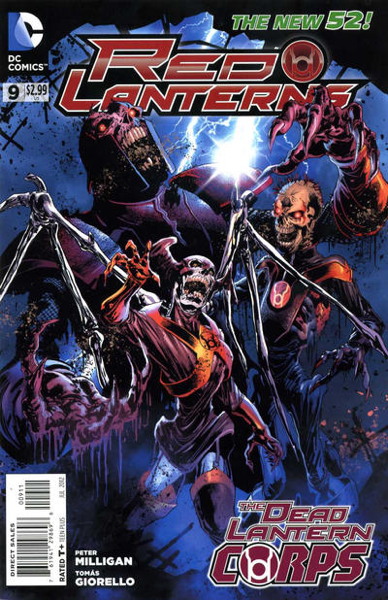
Interestingly, I noted in my discussion of the Green Lantern books that “four were too many, but it wouldn’t surprise me if they added a fifth” and, well, hello solo Sinestro series (which I kinda pushed for in those older posts of mine). In retrospect, I did enjoy the GL books from this period, which (coincidentally I’m sure) were among the least-affected by the New 52/Flashpoint changes of the Big Name DC titles. Plus, I’m in the bag for Green Lantern stuff already, and somehow too many GL titles didn’t burn me out. …Reading my old recaps did remind me 1) Red Lanterns was a far better series than it had any reason to be, and 2) I miss Larfleeze. He had a later-wave short-run New 52 title that I liked quite a bit.
Okay, to the Super-books…I thought then, and still do now, that the main Superman book by George Perez was cluttered and confused, though as we’ve learned in the years since Perez faced some editorial issues on that book so it’s not entirely on his shoulders. Plus, as I’ve said before, if Perez can’t make your costume look good, then the problem is with the costume. Anyway, remember when Lois had another love interest? That blonde guy? Whathsiname? That was weird.
Okay, I’m supposed to be focusing on the titles I liked here, but reminding myself how crummy Superman was makes me appreciate Action, with Grant Morrison writing “Young Superman,” all the more. I’m sure he faced as much editorial finagling as Perez did, but somehow Morrison managed to make it work, mostly, as I recall. After Morrison left, both books kinda fell into the doldrums ’til we got the “Superman’s Identity Revealed!” storyline, which was actually compelling and then eventually undone, of course, which I’m sure isn’t a precursor for anything happening in the Superman books now.
Also of note in my original analyses, I said that reading these Superman books was like reading an “Elseworlds” or parallel-Earth Superman book. Given how this version of the character was eventually replaced by the post-Crisis/pre-Flashpoint Superman, I guess the DC Continuity Gods agreed.
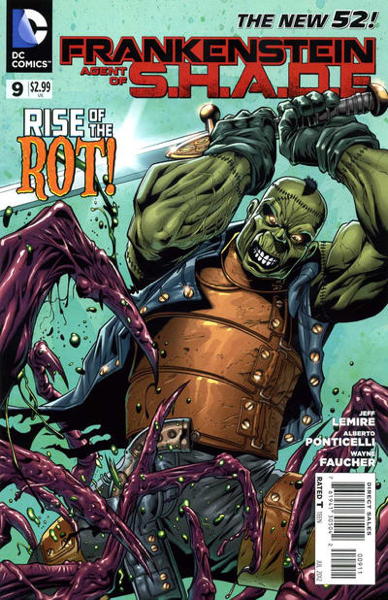
Some of the oddball books were fun as well…that O.M.A.C. series was definitely Kirby-Ahoy, as it should have been. It was too beautiful for this world, alas, and was amongst the first wave of cannings. Frankenstein, Agent of S.H.A.D.E. was also a blast of welcome weirdness, one that didn’t depend on any of the New 52 nonsense to just do what it did. In fact, neither did OMAC, really. It’s almost like the farther removed from the “event,” the better the books are.
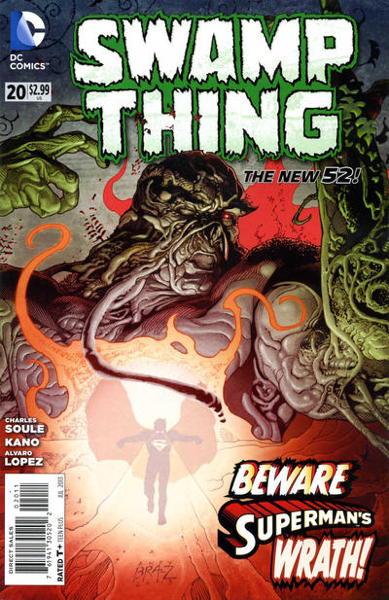
The obvious one you’re probably expecting me to mention is Swamp Thing, which, yes, I liked well enough. The main issue with these is a fanboy-ish one, that arbitrary changes were made to the character’s history and supporting characters (especially Arcane) that don’t really add anything except “it’s different now.” I’ve gone on about this before, and my own realization that they’re not writing these for people who’ve read every single comic with Swamp Thing in it, but for new-ish readers who may be vaguely familiar with ol’ Moss-Head. But overall I think I enjoyed the comic, once they got past the set-up and Swamp Thing was actually in the book.
It’s funny but Justice League Dark was a title I was lukewarm on at first, but it became a comic I enjoyed quite a bit and still follow now, even if it’s been relegated to a back-up in the main Justice League title. And no, not just because Swamp Thing is in it…I like seeing all the horror characters just sort of crammed in here together, plus Detective Chimp. What kind of soulless monster doesn’t like Detective Chimp?
All-Star Western I didn’t pick up ’til the time-travel stuff kicked in, because I do love Jonah Hex travellin’ through time. I know, I know, recent Jonah Hex comics were good the whole time, but it took the gimmick to get me in there. I’m shallow, what can I say. (Remember that time travel stuff started as part of DC’s planned “WTF?” cover stunt ’til someone realized “maybe having an implied ‘fuck’ on the cover isn’t the image we want to sell?” Oh, for those pre-Titans TV show days….)
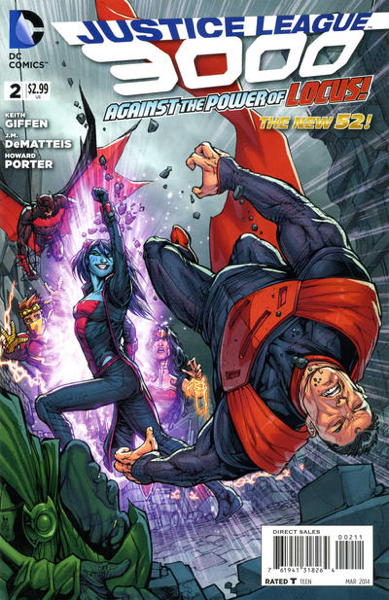
A couple later-wave New 52 books I really enjoyed, like Justice League 3000 (then 3001). I got a real “anythiing could happen/L.E.G.I.O.N. ’89 vibe from it, which 1) was helped along by being new characters removed from regular DC Universe happenings, and 2) L.E.G.I.O.N. writers Keith Giffen and J.M. DeMatteis wrote this too. I really kept hoping they’d bring this back someday, but given DC’s current publishing strategies, seems unlikely.
In addition: Constantine (fun seeing Johnny playing in a superhero universe again), Batwoman (stunning art), Animal Man (can’t think of a specific reason why I liked it, but I always like Animal Man), Secret Six (writer Gail Simone being evil, always a positive in my book), Batman Incorporated (continued over from pre-Flashpoint, which remained good but felt undermined by the relaunch).
So as you can see, I did like quite a few of the New 52 books. I mean, I couldn’t read everything, but what I kept up with I enjoyed (except maybe most of the Superman comics, which I sorta hung in there on out of inertia, which is a terrible way to read a comic but a lot of us have one of those in our reading lists). There were a couple of books I mentioned back then as ones that I liked, but afterward I’d drop (like Aquaman) or I just can’t remember anything about (like Firestorm). Maybe I’d still like them now? Once I find an eighth day in the week, I’ll do some rereading.
ADDENDUM: I am reading your comments, and thank you for them. Just wanted to let you know I’m not ignoring them just because I’m not addressing them in these posts yet. I’ll get to responding eventually!
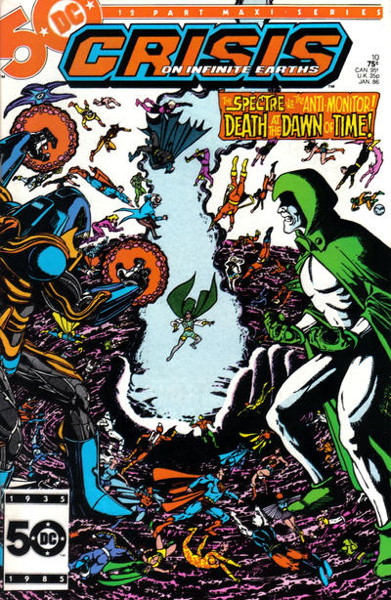
To clarify somewhat regarding my Saturday birthday post…I do find things to enjoy in the various reboots/relaunches/house cleanings that DC (and Marvel too) regularly employ. For example, the big one, Crisis on Infinite Earths…while that’s arguably Patient Zero for all the shenanigans at the Big Two today, it remains a beautifully fascinating comic.
Is it a good comic? I mean, look, if this was the first comic you ever read, well, God bless ya and God help ya too, as this clearly was a funnybook for those with regular admission to the clubhouse. As I said, in retrospect, it was very much solving a problem that perhaps didn’t need a solution (i.e. DC’s supposedly convoluted continuity) by trying to establish the groundwork for a consistency for which comic books, especially superhero comic books, have defiance built into their very DNA. Crisis hadn’t been done for months before creators started finding ways to push back against it, through in-jokes and knowing nods then eventually outright reestablishing what had been specifically done away with by the series. Supergirl and the Barry Allen Flash, done away with absolutely for sure, until they returned. And the ultimate expression of this was the recently -concluded Dark Nights: Death Metal, giving DC its limitless multiverse once again after Crisis had winnowed it down.
Now it remains to be seen what exactly is going to be done with that, after decades of DC releasing event comic after event comic trying to undo, or at least plaster over the cracks, what Crisis had done. But that’s hardly the fault of Marv Wolfman and George Perez, who tried to put out a comic with the nearly impossible task of telling a story while restructuring a fictional milieu pieced together by disparate hands for fifty years. It is, needless to say, beautiful to behold, with Perez absolutely in his element drawing everything and everyone in panels crammed with detail. Every character is essentially the Platonic ideal of itself in this comic.
But I don’t think anyone’s complaining about the art…it’s the story, and the editorial decisions evident therein, that’s the culprit for many. And I can’t blame anyone for thinking so…looking back, it seems wasteful to, say, open up the series by destroying Earth-3, the parallel Earth where the Justice League was an evil crime gang, a fun Silver Age-y idea that was so good that DC kept trying to reinvent it multiple ways over the following years until finally just saying “fine, okay, they’re from a parallel Earth again.”
That destruction had the intended effect at the time, however. It told everyone that nothing was safe, this Crisis series meant business. And boy, as this series was coming out you were on tenterhooks wondering what was going to happen next. The one-two punch of the deaths of Supergirl, immediately followed by the Flash, were appropriately shocking (even though Flash’s demise had been foreshadowed throughout the previous installments).
It is easy to let nostalgia color the memories of the series, admittedly, but there’s no real reason why it shouldn’t. In the context of the time, as the series was released, the perceived staggering importance of what was happening made each issue a must-read, to be absorbed if not outright studied. For someone who read it in real time back then, I can still look at the pages (in my slipcased hardcover edition, in which it was initially collected, natch) and recall that excitement I felt reading the series. I don’t think that’s a thing one should deny, but it should also be recognized as a problem when trying to approach the series critically.
Yes, I very much, emphatically and non-ironically, love Crisis on Infinite Earths. But it’s also very dense to the point of being cluttered, characters are given short shrift with that stilted dialogue in the Wild Wolfman Way, there are some editorial inconsistencies and shoehorning in tie-ins to other titles, and an ending that doesn’t quite stick the landing. Though in that latter case, the decision to allow characters to remember the DC Universe as it was, was generally ignored anyway so no big whoop, but it still felt like a cheat, a denial at least in part to the sweeping changes promised by the story.
There’s a lot of cover in this series, far more than can be really broached in a single blog post written by a later-middle age guy late at night who hasn’t been getting enough sleep lately in the first place. I did just want to let you know…I loved Crisis, still love Crisis, but yeah, it ain’t perfect. And despite knowing in my heart that the ripples it spread across DC, and Marvel too, that persist even today, weren’t intended consequences, it’s difficult to consider the series removed from its position as that epicenter.
Next time: to prove I’m not 100% a crankypants, I’m going to talk about the New 52 books that I liked. SPOILER: not Justice League so much.
Thanks for reading, pals, and for your thoughtful comments.
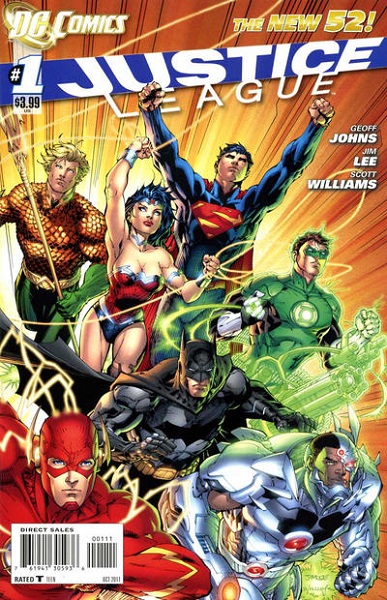
I realize it’s a bit early to be commemorating the 10th anniversary of the launching of DC’s “The New 52” publishing strategy (which began with Justice League #1 in August 2011). However, with today being my 52nd birthday, it seemed, at least to me, like an opportune time to briefly gaze back upon this event and its eventual ignoble end.
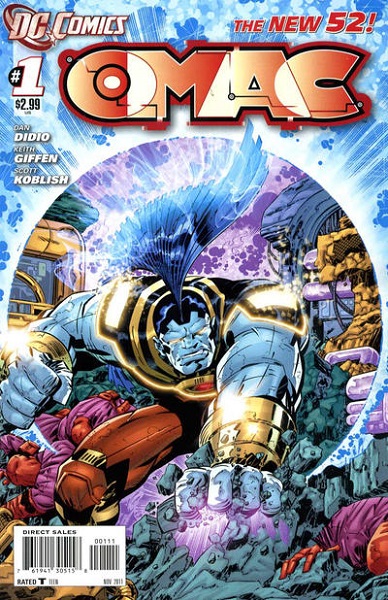
Aside from the online news sources and whatever we were getting in Comic Shop News, I think the main source of into on this particular initiative to which our customers were exposed was that little preview comic DC released listing all the new first issues planned for release in late 2011. It was quite the tantalizing assortment, actually, with the old standbys relaunching with #1s (shockingly including Action Comics and Detective Comics, DC’s two longest-running, highest-numbered books, as well as Batman, also way up there in consecutive numbering) and a variety of other titles attempting to expand the line outside the Supes/Bats/Wondy-related franchises (like O.M.A.C. and Blackhawks).
As I recall, there was some grumbling about knocking Action etc. back to 1, but otherwise people seemed pretty excited about all this. I mean, it was fairly unprecedented (though reminiscent of what Marv Wolfman wanted to do after the conclusion of Crisis on Infinite Earths)…taking an entire existing superhero universe and starting it all from scratch with all-new series.
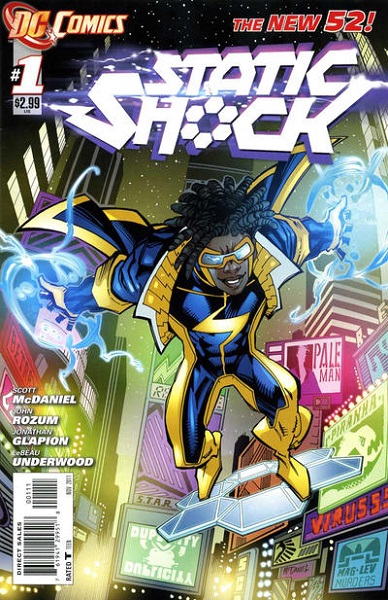
Not that we had a lot of extant or well-established/defined superhero universes with which to do this. Realistically, the only alternative one is Marvel, which followed suit seemingly with relaunching their titles with new #1s at the drop of a hat, after seeing how well DC with with this whole New 52 hoohar.
And well DC did..as I reported shortly after the launch of Justice League, the premiere New 52 release, response from our customers was very enthusiastic, and we sold out of that comic in short order. A restock of first printings for that #1, which we placed but didn’t expect to be filled, was indeed filled and we blew through those as well.
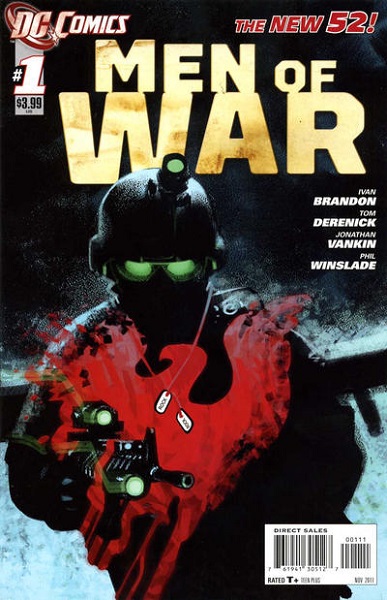
Now whether it was hot because fans were excited about how DC was going to rebuild their universe, or whether they thought it “would be worth something someday” — well, speculation wasn’t quite as rampant then as now, but it wasn’t nonexistent and I’m certain more than a few folks were intrigued by the idea of getting their hands on something in relatively short supply and high demand.
So yes, sales were strong at first, but quickly settled down once the novelty of what DC was doing began to fade. I think of all the titles that passed through this New 52 gauntlet, it was Batman that may have benefited the most, maintaining good numbers throughout the New 52’s run and continuing on through Rebirth and beyond, mostly due to a mix of excellent creative work on the stories combined with the occasional misleading promotion and reasons to get the investors salivating. And plus just the fact that it’s Batman.
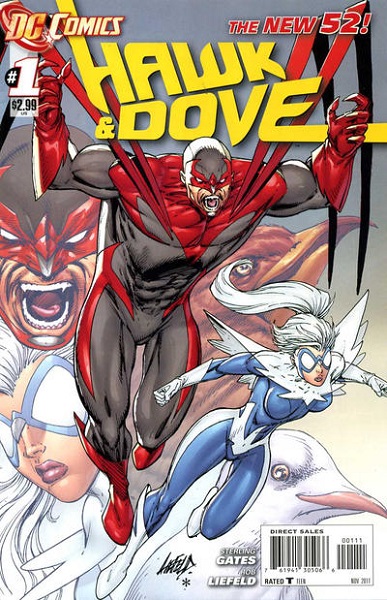
So anyway, the New 52 promised a fresh start, kinda sorta, with their entire line. Some books essentially restarted from the beginning (like the Superman books), others just kinda kept on keeping on (like Green Lantern) barely acknowledging that there even was a reboot. DC’s shared universe, which had hit a 20-year timespan for its “modern age” of superheroes, as of around Identity Crisis, had now been knocked back down to about five years. Older veteran heroes were now younger rookies, or at least closer to their beginnings than they had been.
And it quickly became apparent that the New 52 had been rushed into existence. I expressed some reservations early on about how the conclusion of Brightest Day (the event just before the New 52-introcuing Flashpoint) offered up some epilogues setting up future events…which were all mostly discarded once the DCU was rebooted. Combined with George Perez’s comments about how no one was quite sure was Superman’s deal was in the New 52 (something he needed to know since he was writing the book), and that edits had to be made to Teen Titans stories because their exact history hadn’t been nailed down either. It all smelled of a top-down instruction to DC from the parent company of Warner Bros. to “hurry up and make these funnybooks sell” — reinforced by Perez’s mention that he had to meet demands of folks higher up the food chain than DC’s editor-in-chief Dan DiDio.
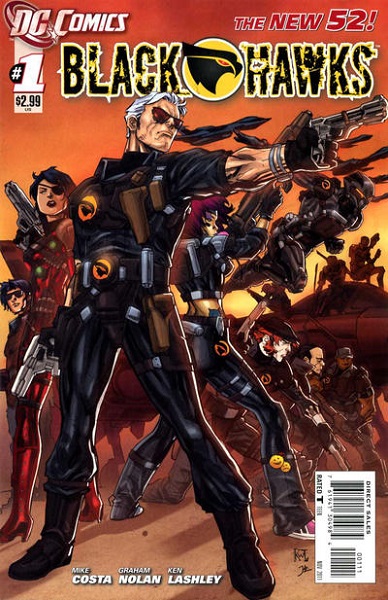
While I was certain at the time this was DC’s “last chance” at making the comics thing work before it all got handed over to the toy companies or whatever, once the bloom faded off the New 52 sales, and bumps from various gimmicks and events became less effective, and there was once again a linewide refurbishing of all DC’s titles in 2016. Which put lie to my “last chance for DC” thought from earlier.
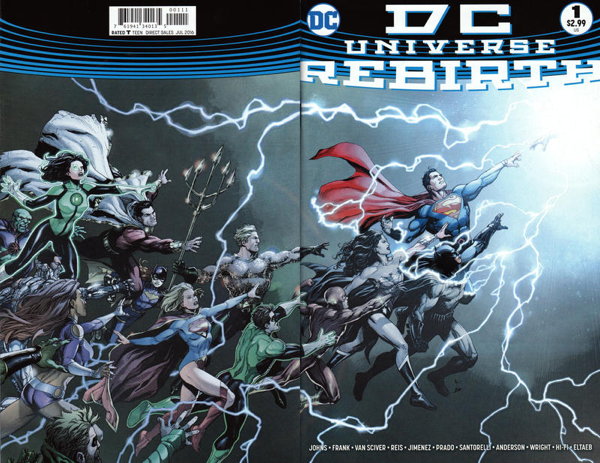
Dubbed “Rebirth,” it seemed to learn from The New 52’s mistakes, in that it all felt a little more…planned, this time around, that it wasn’t just DC immediately asking “how high?” when Warner Bros. told it to jump back in 2011. There seemed to be an effort at fixing what didn’t work with various properties during New 52. In particular, with the Superman books, which went through an extensive, and a little complicated, retooling to discard the New 52 version of Superman, bring back the post-Crisis/pre-Flashpoint. Superman.
And through all of “Rebirth” was a thread, introduced in the final pages of that DC Universe Rebirth one-shot that kicked it all off, that somehow the previously-verboten-from-playing-with-others Watchmen was somehow tied to whatever continuity shenanigans were occurring.
Were fans excited? Oh, sure. Sales on “Rebirth” titles never really reached the overall highs of the New 52, but it certainly got people interested and involved. They were certainly curious about the Watchmen involvement, as DC was finally desperate enough to acknowledge that Alan Moore hated their collective guts and that it wasn’t like they were going to piss him off more, so why not use Watchmen in this fashion?
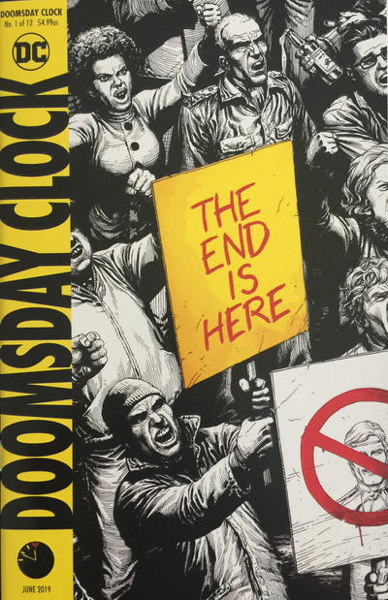
And as it turns out (SPOILERS) we find out in Doomsday Clock that, basically, the New 52 relaunch was due to Dr. Manhattan’s meddling. In essence, that five years of the DC Universe sorta flailing about trying to see what sticks? It was the result of an attack on said DCU by a “bad guy” from outside it. I’ve said in the past that it’s a somewhat clever (and meta) way to deal with the ramifications of a more-or-less defunct publishing initiative, while still being a curious, if not potentially-if-inadvertently insulting, way of recontextualizing the hard work of many creators and editorial staff put in what was almost surely a difficult position.
The New 52, ultimately, was yet another iteration of DC’s attempts at fixing what the decades-old Crisis on Infinite Earths had wrought, where supposedly simplifying and codifying the DC Universe only resulted in more complications and problems. Much of DC’s output and events, like Generations and the Dark Nights: Metal and Death Metal, and the earlier Zero Hour and The Kingdom (with its introduction of “Hypertime”), are tries at reexpanding a fictional world that had been forcibly contracted to meet a demand for consistency that didn’t really need to be met.
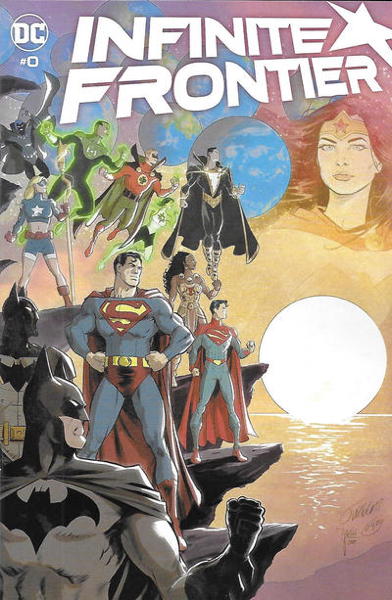
DC’s “Infinite Frontier” is the ultimate refutation of Crisis, in which, spinning off from Death Metal, the DC Universe is now again part of an endless multiverse. How long this will last, and whether this solves whatever DC’s been trying to solve for all these years, remains to be seen. I definitely hope I live long enough to see the company find the balance it’s been seeking, as the other possibility, that I outlive DC Comics, is not one I’d want to experience.
As always, a happy shared birthday to my blogging brother Andrew.
My blogging time is going to be somewhat curtailed over the next couple of days, so don’t expect to the typical Progressive Ruin Wall O’Text™ at least ’til Friday, thanks to some too-early morning appointments over the next couple of days.
So let me answer Wayne’s question very briefly here, where he asks if anyone’s seen the Palisades Park coupons you used to see in Silver Age DCs ever clipped out.
I actually wondered about this myself about a year and a half ago on the Twitters, on the slightly broader topic of finding clipped coupons in comics:
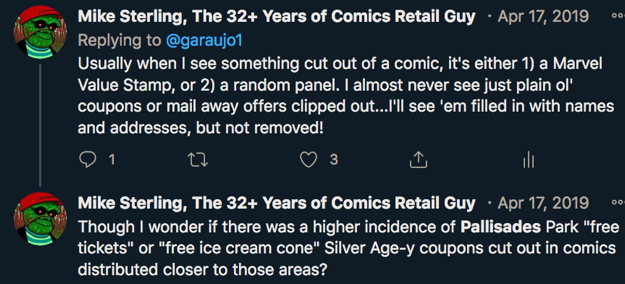
And as you see there, the answer is “nope,” presuming that most of the comics I’ve come across were not from the general area of said park, thus presenting a reduced incidence of clipped coupons. Or kids didn’t want to cut up their comics, which is also possible given the number of surprisingly not-cut-up comics I’ve encountered in collections over the decades. Not saying there were none, but not nearly as many as you’d think, especially with the puzzles and dioramas and whatnot you’d see in Dell Comics, which practically begged kids to ask their parents for permission to use the scissors.
Okay, the primary exception to this is Incredible Hulk #181, which, like, 90% of the time is missing the Marvel Value Stamp. DARN YOU SHANNA THE SHE-DEVIL FANS! …Actually, my theory as to why we see H181 missing the stamp so often where other comics with stamps usually still retain them is because H181 still has significant value and remains sought after even without the stamp. Most other Marvel books with the stamp cut out get tossed in the dollar box or just tossed out…okay, maybe not “tossed out” but boy they don’t go for much, usually.
Anyway, off track, and I want this short. Any of you notice Palisades Park coupons missing from your books? Just curious if anyone’s noticed this.
Roel asks
“Hi Mike! If I wanted to understand current DC continuity, what is my best resource? Is there a website that would help clarify where things stand, and maybe point out key issues that can get me up to speed? Thanks for any suggestions!”
Hi Roel! Boy, that’s a doozy of a question, particularly when it comes to DC Comics and its shared superhero universe. Ever since Crisis on Infinite Earths, DC continuity has been a patchwork mélange of refits, restarts and reboots, a constant schizophrenic scramble forwards yet backwards trying to put everything back in the original packaging while also simultaneously declaring their product “new!” and “improved!”
But even that continuity eventually felt generally smoothed out and consistent compared to the kicking-over-of-the-table “New 52” initiative, a publishing strategy that to all appearances was a last-second decision, so deleterious to DC’s universe that if it had been much planned ahead of release, one could be forgiven for thinking they were deliberately trying to reinvent and outdo the confusion that followed Crisis on Infinite Earths.
In fact, it was such a mess that DC was compelled to follow up with the linewide “Rebirth,” with more restarts and…maybe not so much “reboots,” but rejiggerings of characters and concepts across the board. Compared to the New 52, Rebirth felt like a little more thought was put into it, a little more care was taken to keep the things that worked, and to try to fix the things that didn’t work. Most notable, perhaps, was getting rid of the mostly* objectionable New 52 version of Superman and replacing him with the preferred post-Crisis/pre-New 52 one (to no small measure of irony to those of us who remember the negative reaction to that Superman’s introduction in the ’80s).
The ultimate overarching statement of “Rebirth” was “oh yeah, the New 52? That was actually Watchmen‘s fault” as explained in Doomsday Clock. When you write off a publishing initiative in-universe as the result of an attack by a “bad guy,” that certainly sends a message.
Now, my friend Roel, I know none of this really answers your question. All I’m trying to do is explain why your question is hard to answer. The best response I think to getting a handle on the current version of the DC Universe is maybe getting your hands on a copy of DC Universe Rebirth, the 80-page one-shot that kicked off what’s going on now. DC’s usually pretty good about publishing occasional one-shots that give you an idea where everyone’s at just prior to whatever event is about to happen (Countdown to Infinite Crisis was another). Now these one-shots are set-ups, of course, establishing mysteries and situations to be dealt with over the next year or four of DC Comics, but they do provide an overview of its universe as it stands At That Moment.
In DC Universe Rebirth‘s case, its eventual resolution in Doomsday Clock ended up not really resulting in anything of any impact on the mainline universe. The ballyhooed “return of the Legion of Super-Heroes” it was supposed to bring about already happened before the series concluded, for example. So, basically, you could read just this and not miss a whole lot.
If you wanted to jump into the DCU as it stands now, however, just jump in with whatever character you like, and eventually you’ll get an idea of whatever the prevailing continuity is, particularly in relation to whatever title you’re reading. Now, Justice League could be the most wide-ranging of the titles, as it should give you whatever the current accepted DC Universe versions of the primary superhero characters. You may or may not get specifics of each character from their own titles…like, maybe they’ll mention that Superman’s identity is now public, for example.
I mean, aside from that…perhaps your best bet is to not worry about continuity, and just enjoy the books you enjoy. Let continuity sort itself out. And chances are, with DC’s recent cuts and reorganizations, we could very well be heading to another “fixing” of DC’s publishing line. Maybe not an explicit reboot, but I’ve put my dime down on a reworking everything into a shape that’s a little more media-adaptation friendly, more accessible and less tied to the minutia of a shared universe.
Okay, you’d asked for websites that could set you straight. Well, frankly, I’d advise you to avoid all comic book content online as that way lies madness…surely reading my site has taught you that! But you can probably find some pretty good resources just by Googling “dc comics reading order” and you’ll get some folks who’ve already done the hard work of figuring out what to read and where.
And naturally there’s always Wikipedia. Not always perfect, but given the obsessive nature of the sort of comic fans who’d spend time editing Wikipedia articles, chances are they’d do a reasonable job explaining whatever recent histories of characters you’d need. FULL DISCLOSURE: this is coming from the fella who once edited the “Abby Arcane” Wiki page to correct the first appearance notation.
There are also specialized Wikis for purt’near everything. This DC Fandom Wiki would likely come in useful.
I’m sure there are more, and that friendly readers of this site will drop their suggestions in the comments. I hope this helps, Roel!
* Yes, the character did have some good moments, but never felt like he quite “gelled,” never really felt like Superman.
Wayne sallies forth with this query:
“…What are *your* memories of it as you heard from others (or read up on) over the years?”
I was born in 1969 (as the ever-changing tagline on my website might suggest) and while I did read various comics throughout the 1970s, I didn’t really start being a “comic collector” in earnest ’til 1980-1, aside from my short-lived attempt at getting each new Star Wars off the shelf. I was, what, 9 when the original DC Implosion happened in 1978, and since I was only picking up the occasional comic book here and there at the time (or badgering my parents into buying them for me) I wasn’t aware of it at all.
But how I became aware of it later…I’m not sure, honestly. It’s just one of those bits of background noise accumulated over the years as I read more comics and bought more back issues (usually from second-hand bookstores, then from actual comic shops). I don’t think I ever wondered “huh, there sure seemed to be a lot of comics that got canned around the same time” or anything.
If I had to hazard a guess, I would bet my first awareness of the DC Implosion came from spotting the Cancelled Comic Cavalcade entry in the Overstreet price guide. I remember getting my hands on one of the guides pretty early on and just poring through the thing, looking at all the different titles and the tiny black and white cover images that adorned each page. That must be where I first learned of a mass cancellation of books at DC, seeing that there were limited run collections of the unpublished comics.
I’m also going to presume that my love of fanzines and prozines (stuff like The Comic Reader and The Comics Journal) helped flesh out my knowledge of the event, particularly once I started picked up back numbers of those that came out as the Implosion was occurring. What was nice about the Comic Book Implosion book that I noted at the beginning of Wednesday’s post was that it pieced together excerpts from articles and interviews from the time, including material that I already had in my own collection of ‘zines, and gave me more of a narrative, and an understanding, of what happened and how. I actually learned quite a bit from the book (including the whys and wherefores of DC’s Dollar Book line — to entice newsstands into carrying a more profitable form of comic — as well as letting me know that some of the Dollar Books being physically taller was a deliberate strategy).
Okay, enough commercials for Two Morrows books, let’s get back to what’s going on at DC now, about which I don’t really know anything more. I did post on Twitter just some thoughts about what could happen, based on what little I read in some of the more reliable articles on the matter. I was going to summarize, but it’s late, I’m all headache-y from lasers in the eyeball this morning, and so I’m just gonna cut ‘n’ paste here:
Comics prediction re: the Warners/DC reorg – we’re going to see Jon Kent and Damian Wayne go away, as well as the Lois/Clark marriage. I can imagine the line as a whole reverting to almost Silver/Bronze-y type comics.
I mean, just modern *enough* to appeal to today’s readers, but simplified continuity, no more reality-bending Crisis type events/reboots, definitely no Dr. Manhattan’s naughty bits sharing a panel with Mary Marvel.
Just sort of a gut feeling based on what I’ve been seeing around. No idea what’s actually going to happen, but I think my assumptions could come to pass.
Meanwhile, on the DC Universe streaming service message board, it’s a pretty fair mix of “THE END IS NEAR” and “surely they won’t take THIS away from us!”
Anyway, I know it’s WAY too early to say, but the general belief is that the focus will be on exploiting DC’s properties in licensing and media, with comics more as an afterthought. I mean, that’s not much different from before…
…but it sorta sounds like they’ll want the comics to be more “marketing/licensing” friendly, so streamlining the continuity (if continuity even remains a concern) and matching public perception of the characters feels like the simplest path to that goal.
Again, just talkin’ out my butt.
I’d be sort of okay with a more accessible DC Comics, but I wish we could have reached that state without the human cost. However, the idea that any new, challenging material may be resisted (i.e. MISTER MIRACLE) is kinda rough.
I don’t know if there had been any new news about what’s happening at DC, as I’ve been otherwise occupied (LASERS IN THE EYE an’ all) but given what little has been said, I don’t think any of this is out of the question. Other folks responded on Twitter noting that there may be a reemphasis of focus on Young Adult and all-ages titles for bookstores, while others lamented the end of seeing any new challenging work from DC ever again (my thought: maybe curtailed for now, but maybe will creep slowly back in). Some suggested, both there and on this site, possible licensing of characters to other publishers (like Marvel’s deal with the Marvel Action line at IDW). It’s possible, but maybe we’ll see more backlist material get reprinted by other publishers, letting them take the financial risk? I don’t know. Nobody knows.
Anyway, I’m sure we’ll be returning to this topic again and again for the foreseeable future, so I’m going to end it here tonight and we’ll talk again on Monday. Thanks for reading, pals.
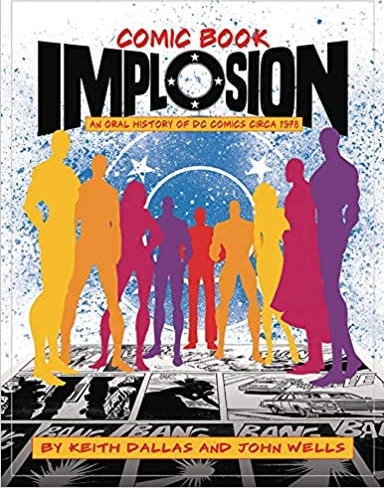
So I just recently finished reading the above book detailing the history of the “DC Implosion,” in which DC Comics in the 1970s is hit with immense cutbacks by its parent company resulting in lost jobs and a linewide culling of books in the midst of a planned publishing expansion.
Well, it happened again, with layoffs across Warner Bros. also hitting DC…not that DC was in the middle of a big publishing push, and no idea what’s going to happen to any of the comics they are publishing, but I expect it’s not good news. But plenty of people lost their jobs both at DC and the DC Universe streaming service, and of course my condolences and best wishes to those folks so affected.
I saw a lot of doomsaying online about how this was the end of DC Comics, which seems…premature. Okay, it’s probably the beginning of the end of the streaming service, which seemed doomed from the get-go, and its new shows all are migrating to HBO Max anyway. (Here’s hoping they find a way to keep the digital library of comics going.) DC’s inhouse collectibles division DC Direct is done as well. But DC Comics itself…it’s been through tough times before, and I feel like if this was the end, it would have just been shuttered completely instead of cut down and a new person being installed to oversee things.
According to that last link, there are publishing plans in place for DC going forward, though it looks like the Black Label line may be on its way out. Which is a shame, given that it’s been quite successful at least for me, but apparently, according to said article, DC’s new general manager ain’t a fan of the more “grown-up” comics so don’t expect a new Vertigo to arise from the company anytime soon. There’s a lot of other speculation in that article regarding what will happen (larger push to digital? licensing characters to other publishers?), but we’re all going to have to wait and see.
I’m not sure how I feel about any of this yet. I mean, aside from my sympathies for everyone losing their jobs, of course, especially right now in this COVID-19 impacted society we have here in the U.S. As a retailer I have some uncertainty, naturally, given I don’t know what this means for titles currently being released, or for DC’s graphic novel backlist. I’m hopeful that there will be a leaner, stronger DC Comics that emerges from this reorganization, though the human cost to get there is admittedly terrible. I just have to hope it all works out in the end, but I have to prepare for what will surely be some rough times ahead for the industry. Not that I haven’t been riding out those rough times since the ’90s comics bust, right?
So remember last week when we were talking about the Marvel/DC crossovers, and which ones I thought we the good’uns? Well, a couple of you had questions, so let me address those first:
John Lancaster tossed his line into the water with
“Seems to me that a lot of good crossovers that aren’t Marvel/DC are getting forgotten”
and then he proceeds to list some ones that are indeed good. My focus of the post was specifically just the Marvel/DC encounters, but I had planned on address some of the crossovers involving other companies as well. In other words, let’s talk about Deathmate:
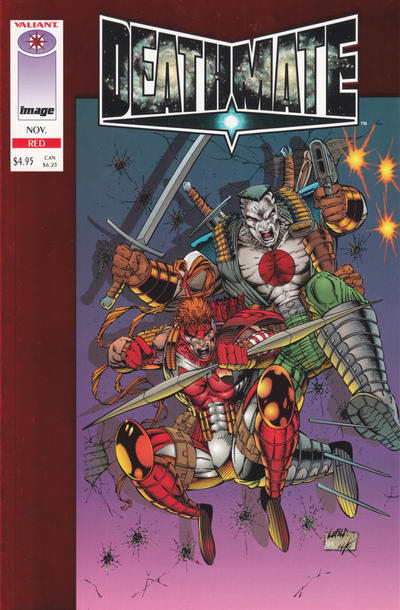
Ah, just ribbin’ ya a little, and I’ve already talked about Deathmate at length if you want to go relive that.
But yes, there were plenty of crossovers among the smaller companies, sometimes even with either Marvel or DC. A personal favorite is 1994’s Archie Meets the Punisher (AKA Punisher Meets Archie, as per the Marvel-published diecut cover version):
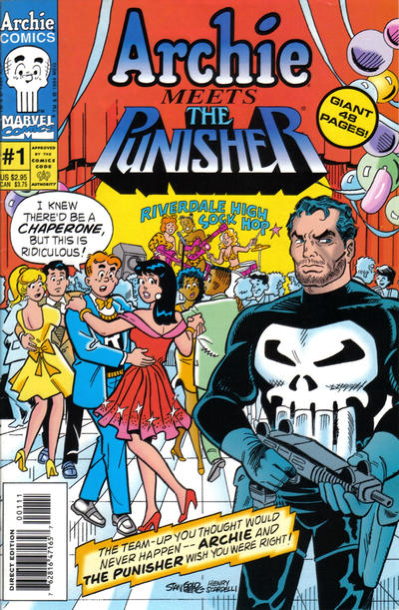
General reaction to this at the time when this was announced was “Whaaa–!?” and for good reason, though it turned out to actually be a bit of fun. with art by Stan Goldberg and John Buscema.
Archie Comics, in fact, seems pretty game to cross over their character with other companies even to this say. John mentioned Archie Vs. Predator (which featured some fairly shocking content for an Archie comic, but in this post-Afterlife with Archie world, pretty much anything is fair game, I suspect). We’ve also had Archie meet up with Batman ’66, and the Archie gang turned up in issue #13A of Gen13 back in ’96:
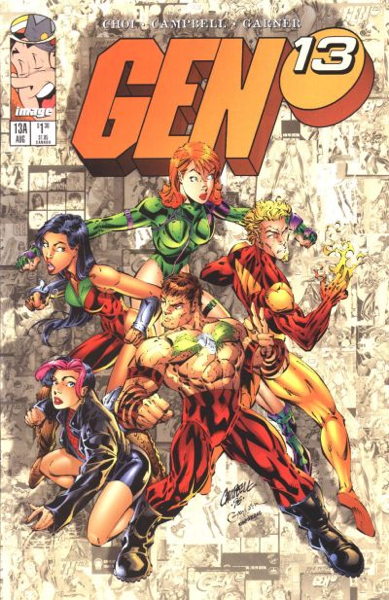
I remember that one surprising me more than the Punisher crossover, for some reason. Like, Marvel and the Punisher were fairly “mainstream” and high profile, versus a relatively unknown (though admittedly popular) indie book. Wasn’t sure what Archie was going to get out of that…except, after thinking about it for a second, exposure of the characters to an audience that might otherwise not have paid attention to them, duh.
I suspect creator-owned titles are a little easier to negotiate with when it comes to crossovers like this, simply due to less layers of bureaucracy being involved. I mean, I’m about to exaggerate a little, but assembling the deal to make this happen feels like it probably only took about five minutes:
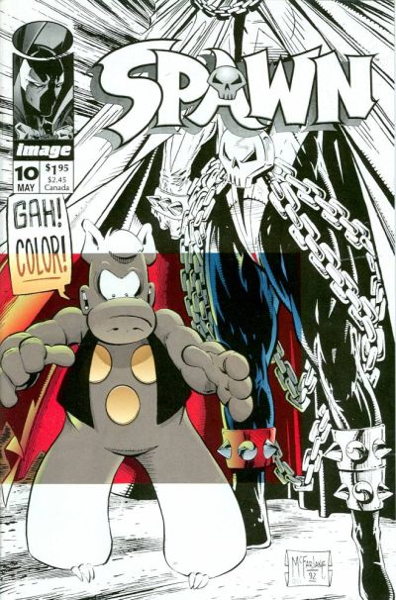
Don’t write to tell me I’m wrong, I know I am, but you have to admit the process of Todd ‘n’ Dave getting together to team up Spawn and Cerebus probably was a great deal less involved than JLA/Avengers. And Mr. Sim wasn’t shy about letting Cerebus show up here and yonder in other people’s independent comics, which again probably consisted of a fax asking if they could use the character, and Dave faxing back “yeah, sure.” Okay, granted the two that immediately come to mind are Journey and normalman, both Aardvark-Vanaheim publications at the time, like Cerebus, but I know there were others. Alas, the fabled X-Men/Cerebus didn’t happen (beyond a piece of promo art). But look, all I got for that Mr. Monster/Swamp Thing proposed team-up was a single piece of art as well:
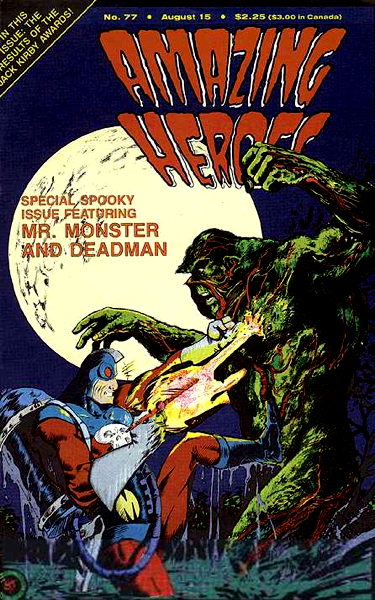
…so we all just have to suffer.
More on specific crossovers next time, maybe, but let’s address Thom H.’s query briefly:
“I mean, is it that difficult or costly to have an inter-company meeting to discuss splitting the costs and profits 50/50? It seems like something two lawyers could do via email.”
As it was explained to me by someone also in the comics publishing business, it’s the potential profits that are a problem. Apparently neither Marvel nor DC feel like they’d be making enough profit on bringing any of these back in print, that having only 50% of the take isn’t enough. Now it seems to me making a little money is better than making no money (believe me, I’ve told myself that plenty of times at the shop after looking at the end-of-day receipts) but the Big Two don’t see it that way, I guess.
My half-facetious solution was that each company get the rights to publish their own paperbacks reprinting their crossovers…like, DC could publish JLA/Avengers under their own trade dress, and Marvel could do the same, titling it Avengers/JLA and putting it out with their trade dress, and they could agree to just keep all the profits from their versions. But I can see other problems arising from this (like, what happens when Marvel lets theirs fall out of print almost immediately…can DC still keep publishing their own?) so that may not be much of a solution.
So I don’t know, Thom…maybe when we enter a cashless society then someday all these comics will come back into print. In the meantime…WRITE YOUR CONGRESSPERSON! I’m sure they have nothin’ else going on right now, let them deal with this issue.
Okay, more crossover talk next time? Eh, we’ll see. In the meantime, be good to each other, wear your masks and wash your hands, and for God’s sake quick setting off your firecrackers at night, old comic shop owners need to get their beauty sleep.
« Older Entries
Newer Entries »



























